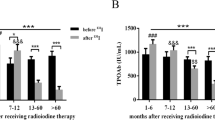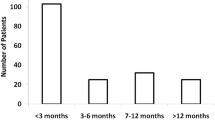Abstract
Background
Thyroid peroxidase autoantibodies (TPOAbs) are frequently observed in Graves’ disease (GD) and tend to persist in patients even after successful treatment with antithyroid drugs. However, there is a lack of consistent data regarding the prognostic significance of TPOAbs during and after non-ablative treatment for Graves’ hyperthyroidism.
Aim
To assess the prognostic value of TPOAbs on the long-term outcome of GD patients, who were in remission after the use of antithyroid drugs (block-and-replace regimen).
Subjects
100 remitters were retrospectively investigated for factors associated with the 5-year course of disease recurrence and compared to 60 age/sex-matched patients with intractable GD.
Results
Mild hyperthyroidism, low baseline thyroid-stimulating antibodies levels, and small goiters were predictive of remission. Once attained, the remission was shorter in younger patients, patients with declining post-treatment TSH values, and negative baseline TPOAb levels. The 5-year cumulative incidence of relapse incrementally increased from 24 to 44 to 70 % across decreasing TPOAb tertiles (log-rank, p = 0.00056; the lower tertile representing TPOAb-negative cases). The age-of-onset (p = 0.034), and the baseline TPOAb value [upper tertile, hazard ratio (HR) 0.25; 95 % confidence interval, 0.11–0.59; p = 0.0014; middle tertile, HR 0.47 (0.24–0.9); p = 0.024; Cox regression] were inversely associated with late (>12 months) relapse rates in a level-dependent manner. In contrast, serum logTSH measured 6 months after drug discontinuation was inversely associated with hazard rates at all time points (p = 0.0005).
Conclusion
Baseline TPOAb positivity is an independent indicator of long-term remission in GD patients who have been successfully treated, but the mechanism of action and causal relations remain unknown.


Similar content being viewed by others
References
Davies TF, Roti E, Braverman LE, DeGroot LJ (1998) Thyroid controversy-stimulating antibodies. J Clin Endocrinol Metab 83:3777–3785
Feldt-Rasmussen U, Glinoer D, Orgiazzi J (1993) Reassessment of antithyroid drug therapy of Graves’ disease. Annu Rev Med 44:323–334
Sato T, Takata I, Taketani T, Saida K, Nakajima H (1997) Concurrence of Grave’s disease and Hashimoto’s thyroiditis. Arch Dis Child 52:951–955
Paschke R, Vogg M, Swillens S, Usadel KH (1993) Correlation of microsomal antibodies with the intensity of the intrathyroidal autoimmune process in Graves’ disease. J Clin Endocrinol Metab 77:939–943
McLachlan SM, Nagayama Y, Rapoport B (2005) Insight into Graves’ hyperthyroidism from animal models. Endocr Rev 26:800–832
Guilhem I, Massart C, Poirier JY, Maugendre D (2006) Differential evolution of thyroid peroxidase and thyrotropin receptor antibodies in Graves’ disease: thyroid peroxidase antibody activity reverts to pretreatment level after carbimazole withdrawal. Thyroid 16:1041–1045
Kaguelidou F, Alberti C, Castanet M et al (2008) Predictors of autoimmune hyperthyroidism relapse in children after discontinuation of antithyroid drug treatment. J Clin Endocrinol Metab 93:3817–3826
Schott M, Eckstein A, Willenberg HS, Nguyen TB, Morgenthaler NG, Scherbaum WA (2007) Improved prediction of relapse of Graves’ thyrotoxicosis by combined determination of TSH receptor and thyroperoxidase antibodies. Horm Metab Res 39:56–61
Hamada N, Ito K, Mimura T et al (1987) Retrospective reevaluation of the significance of thyroid microsomal antibody in the treatment of Graves’ disease. Acta Endocrinol (Copenh) 114:328–335
Lavard L, Perrild H, Jacobsen BB, Høier-Madsen M, Bendinelli G, Vitti P (2000) Prevalence of thyroid peroxidase, thyroglobulin and thyrotropin receptor antibodies in a long-term follow-up of juvenile Graves disease. Autoimmunity 32:167–172
Takaichi Y, Tamai H, Honda K, Nagai K, Kuma K, Nakagawa T (1989) The significance of antithyroglobulin and antithyroidal microsomal antibodies in patients with hyperthyroidism due to Graves’ disease treated with antithyroidal drugs. J Clin Endocrinol Metab 68:1097–1100
Hirota Y, Tamai H, Hayashi Y et al (1986) Thyroid function and histology in forty-five patients with hyperthyroid Graves’ disease in clinical remission more than ten years after thionamide drug treatment. J Clin Endocrinol Metab 62:165–169
De Moraes AV, Pedro AB, Romaldini JH (2006) Spontaneous hypothyroidism in the follow up of Graves hyperthyroid patients treated with antithyroid drugs. South Med J 99:1068–1072
Werner SC (1977) Modification of the classification of the eye changes of Graves’ disease: recommendations of the Ad Hoc Committee of the American Thyroid Association. J Clin Endocrinol Metab 44:203–204
Kusić Z, Novosel SA, Dabelić N et al (2009) Croatia has reached iodine sufficiency. J Endocrinol Invest 26:738–742
Glinoer D, de Nayer P, Bex M, Belgian Collaborative Study Group on Graves’ Disease (2001) Effects of l-thyroxine administration, TSH-receptor antibodies and smoking on the risk of recurrence in Graves’ hyperthyroidism treated with antithyroid drugs: a double-blind prospective randomized study. Eur J Endocrinol 144:475–483
Vitti P, Rago T, Chiovato L et al (1997) Clinical features of patients with Graves’ disease undergoing remission after antithyroid drug treatment. Thyroid 7:369–375
Quadbeck B, Hoermann R, Roggenbuck U et al (2005) Sensitive thyrotropin and thyrotropin-receptor antibody determinations one month after discontinuation of antithyroid drug treatment as predictors of relapse in Graves’ disease. Thyroid 15:1047–1054
Stassi G, De Maria R (2002) Autoimmune thyroid disease: new models of cell death in autoimmunity. Nat Rev Immunol 2:195–204
McLachlan SM, Rapoport B (2007) Thyroid peroxidase as an autoantigen. Thyroid 17:939–948
Metcalfe RA, Oh YS, Stroud C, Arnold K, Weetman AP (1997) Analysis of antibody-dependent cell-mediated cytotoxicity in autoimmune thyroid disease. Autoimmunity 25:65–72
Rodien P, Madec AM, Ruf J et al (1996) Antibody-dependent cell-mediated cytotoxicity in autoimmune thyroid disease: relationship to antithyroperoxidase antibodies. J Clin Endocrinol Metab 81:2595–2600
McLachlan SM, Rapoport B (2013) Thyrotropin-blocking autoantibodies and thyroid-stimulating autoantibodies: potential mechanisms involved in the pendulum swinging from hypothyroidism to hyperthyroidism or vice versa. Thyroid 23:14–24
Nielsen CH, Brix TH, Leslie RG, Hegedüs L (2009) A role for autoantibodies in enhancement of pro-inflammatory cytokine responses to a self-antigen, thyroid peroxidase. Clin Immunol 133:218–227
Karanikas G, Schuetz M, Wahl K et al (2005) Relation of anti-TPO autoantibody titre and T-lymphocyte cytokine production patterns in Hashimoto’s thyroiditis. Clin Endocrinol (Oxf) 63:191–196
Xie LD, Gao Y, Li MR, Lu GZ, Guo XH (2008) Distribution of immunoglobulin G subclasses of anti-thyroid peroxidase antibody in sera from patients with Hashimoto’s thyroiditis with different thyroid functional status. Clin Exp Immunol 154:172–176
Guo J, Jaume JC, Rapoport B, McLachlan SM (1997) Recombinant thyroid peroxidase-specific Fab converted to immunoglobulin G (IgG) molecules: evidence for thyroid cell damage by IgG1, but not IgG4, autoantibodies. J Clin Endocrinol Metab 82:925–931
Tandon N, Morgan BP, Weetman AP (1992) Expression and function of membrane attack complex inhibitory proteins on thyroid follicular cells. Immunology 75:372–377
Park ES, Kim H, Suh JM et al (2000) Thyrotropin induces SOCS-1 (suppressor of cytokine signaling-1) and SOCS-3 in FRTL-5 thyroid cells. Mol Endocrinol 14:440–448
Vanderpump MP, Tunbridge WM, French JM et al (2005) The incidence of thyroid disorders in the community: a twenty-year follow-up of the Whickham Survey. Clin Endocrinol (Oxf) 43:55–68
Mazza E, Carlini M, Flecchia D et al (2008) Long-term follow-up of patients with hyperthyroidism due to Graves’ disease treated with methimazole. Comparison of usual treatment schedule with drug discontinuation vs continuous treatment with low methimazole doses: a retrospective study. J Endocrinol Invest 31:866–872
Laurberg P, Wallin G, Tallstedt L, Abraham-Nordling M, Lundell G, Tørring O (2008) TSH receptor autoimmunity in Graves’ disease after therapy with anti-thyroid drugs, surgery, or radioiodine: a 5-year prospective randomized study. Eur J Endocrinol 158:69–75
Acknowledgments
This work was supported by the Ministry of Science, Education and Sports of the Republic of Croatia (Grant No. 219-2190372-2068).
Conflict of interest
The authors M. Stefanic and I. Karner declare that they have no conflict of interest.
Author information
Authors and Affiliations
Corresponding author
Rights and permissions
About this article
Cite this article
Stefanic, M., Karner, I. Thyroid peroxidase autoantibodies are associated with a lesser likelihood of late reversion to hyperthyroidism after successful non-ablative treatment of Graves’ disease in Croatian patients. J Endocrinol Invest 37, 71–77 (2014). https://doi.org/10.1007/s40618-013-0026-9
Received:
Accepted:
Published:
Issue Date:
DOI: https://doi.org/10.1007/s40618-013-0026-9




